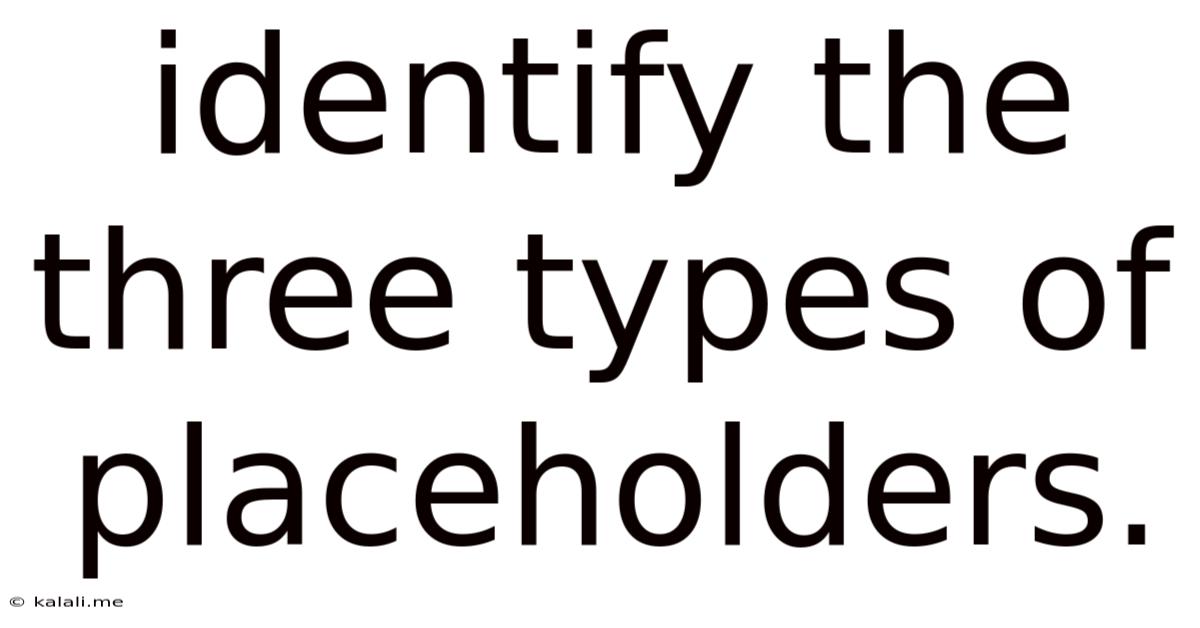Identify The Three Types Of Placeholders.
Kalali
Jun 11, 2025 · 3 min read

Table of Contents
Identify the Three Types of Placeholders: A Deep Dive into Content Management
Placeholders are essential components in various systems, particularly in content management and data processing. They act as temporary containers for information that will be filled in later. Understanding the different types of placeholders is crucial for efficient content creation, data management, and overall system functionality. This article will delve into the three primary types of placeholders: text placeholders, image placeholders, and data placeholders. We'll explore their characteristics, uses, and the benefits they offer.
Meta Description: Learn about the three main types of placeholders: text, image, and data placeholders. Discover their uses in content management and data processing, improving efficiency and organization.
1. Text Placeholders: The Foundation of Dynamic Content
Text placeholders, as the name suggests, are used to represent areas where textual content will be inserted. They are commonly found in:
- Content Management Systems (CMS): Think of the "lorem ipsum" text you often see in website templates. These are text placeholders indicating where actual website copy will go. They allow editors to easily visualize content placement before the final text is written.
- Document Templates: Similar to CMS templates, document templates utilize text placeholders for names, dates, addresses, or other variable information. This streamlines document creation and ensures consistency.
- Email Marketing Platforms: These platforms use text placeholders to personalize emails, inserting recipient names, product details, or other dynamic data. This improves user engagement and campaign effectiveness.
Example: [Name], [Date], [Product Description] are common examples of text placeholders. They provide clear indications of where specific textual data needs to be inserted.
2. Image Placeholders: Visual Guides for Content Layout
Image placeholders serve as temporary visual representations of images that will be added later. They are vital for:
- Website Design: During website development, image placeholders show the intended size and placement of images. This helps designers visualize the overall layout and ensure proper spacing. Common examples include low-resolution images or simple rectangles with text like "Image Here."
- Presentation Design: Image placeholders in presentation templates ensure consistent image sizing and placement, making it easy to update the visuals without altering the overall presentation layout.
- Mockups and Prototypes: Image placeholders are crucial for creating realistic mockups and prototypes, especially in UI/UX design. They aid in visualizing how the final product will look and feel.
Example: A grey rectangle with the dimensions of the intended image, or a low-resolution version of the intended image, are typical image placeholders.
3. Data Placeholders: Dynamic Data Integration
Data placeholders are used to represent locations where dynamic data will be inserted. They are widely used in:
- Databases: Data placeholders are used to represent values that will be entered or calculated within database records. This facilitates efficient data entry and management.
- Software Development: In programming, data placeholders often take the form of variables. They represent data values that will be assigned during program execution.
- Spreadsheets: Formulas often use data placeholders (cell references) to dynamically calculate values based on other cells’ content.
Example: %customerName%, #orderID#, {date} are typical examples showing the variety of ways data placeholders can be expressed depending on the system. These placeholders are filled in with actual data values when the application or program runs.
Conclusion: Mastering Placeholder Types for Efficiency and Organization
Understanding and effectively utilizing the three primary types of placeholders – text, image, and data – is essential for efficient content management, streamlined workflow, and improved organization across diverse applications. Knowing how to leverage these placeholders can significantly improve productivity and enhance the quality of your final product, whether it's a website, a document, or a software application. Mastering this concept is key to building dynamic and adaptable systems.
Latest Posts
Latest Posts
-
How To Beat Stage 7 In Bloxorz
Jul 01, 2025
-
How Much Oz In A Bottle Of Water
Jul 01, 2025
-
How Long Does It Take To Drive 10 Miles
Jul 01, 2025
-
How Many 9s Are In A Deck Of Cards
Jul 01, 2025
-
How Many Pounds Are In 2 5 Kg
Jul 01, 2025
Related Post
Thank you for visiting our website which covers about Identify The Three Types Of Placeholders. . We hope the information provided has been useful to you. Feel free to contact us if you have any questions or need further assistance. See you next time and don't miss to bookmark.